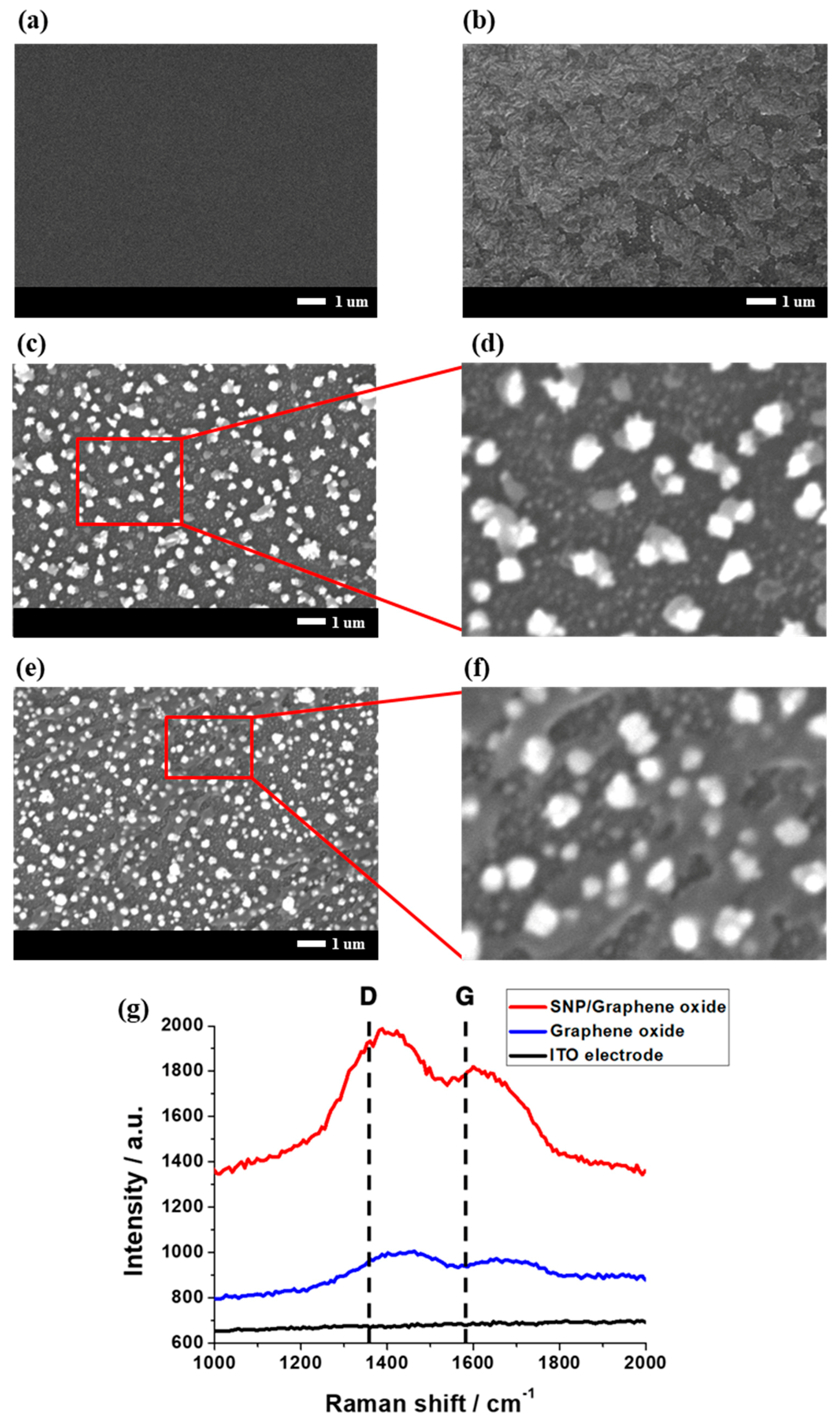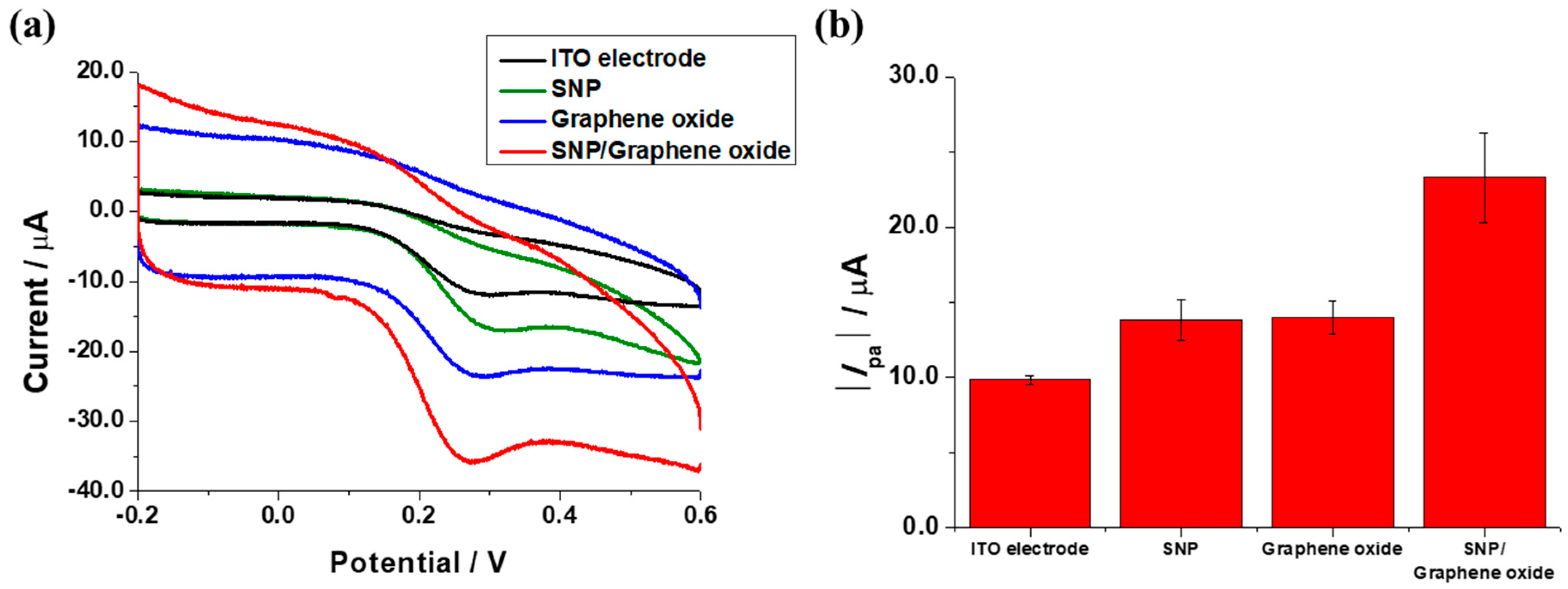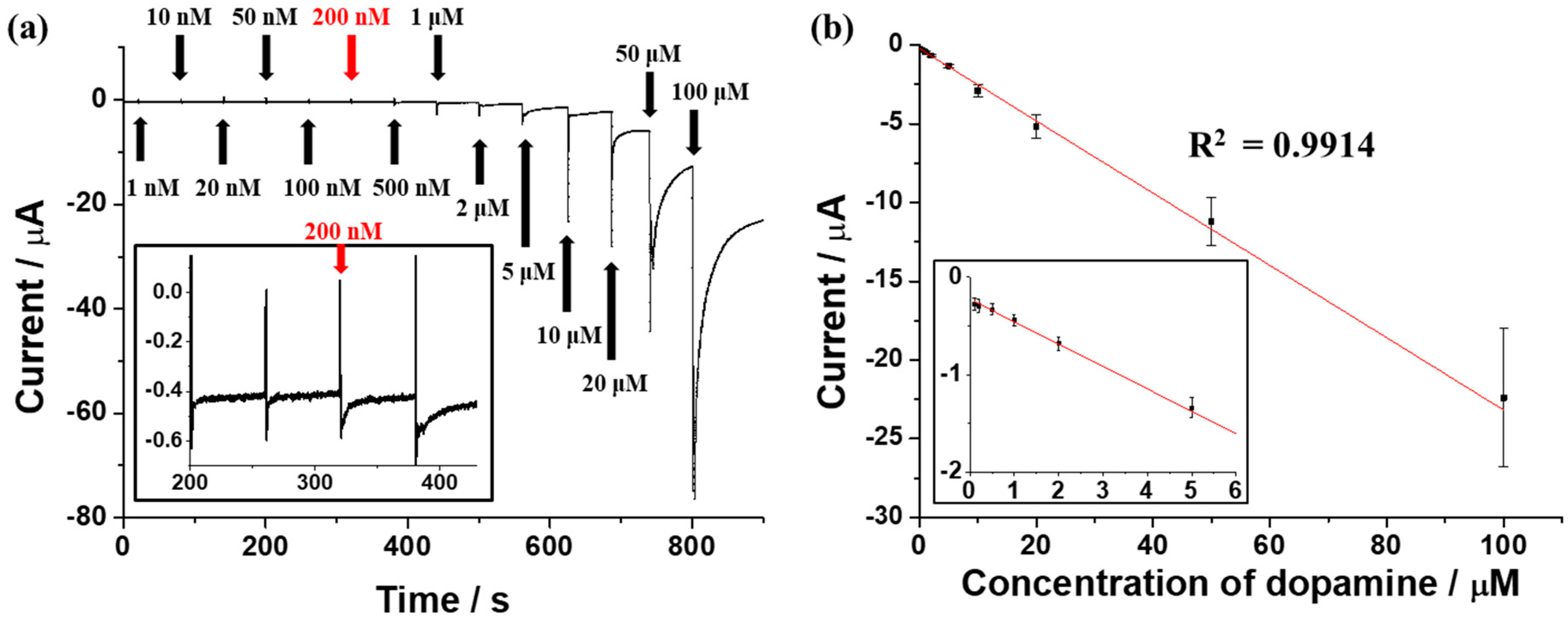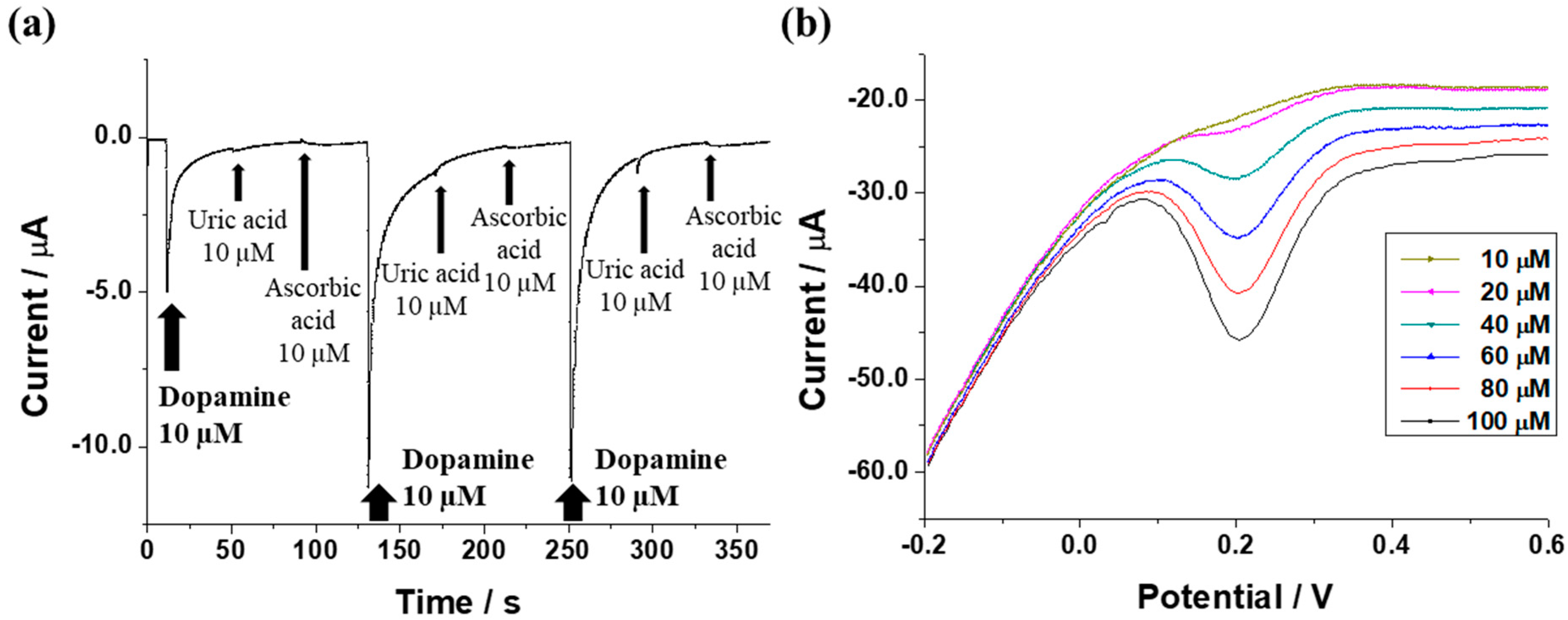Silver Nanoparticle Modified Electrode Covered by Graphene Oxide for the Enhanced Electrochemical Detection of Dopamine
Abstract
:1. Introduction
2. Materials and Methods
2.1. Materials
2.2. Preparation of ITO Electrodes
2.3. Electrochemical Deposition of SNPs and Graphene Oxide
2.4. Electrochemical Measurement of the Modified Electrode
3. Results and Discussion
3.1. Structure of the SNP Modified Electrode Covered by Graphene Oxide
3.2. Confirmation of Signal Enhancement of the SNP Modified Electrode Covered by Graphene Oxide
3.3. Detecting the Performance of the SNP Modified Electrode Covered by Graphene Oxide
3.4. Electrochemical Selective Detection of Dopamine in the Presence of Uric Acid and Ascorbic Acid
4. Conclusions
Supplementary Materials
Acknowledgments
Author Contributions
Conflicts of Interest
Abbreviations
| PD | Parkinson’s Disease |
| ADHD | Attention Deficit Hyperactivity Disorder |
| HPLC | High Performance Liquid Chromatography |
| SNP | Silver Nanoparticle |
| ITO | Indium Tin Oxide |
| CV | Cyclic Voltammetry |
| DPV | Differential Pulse Voltammetry |
| PDMS | Polydimethylsiloxane |
| DIW | Deionized Water |
| SEM | Scanning Electron Microscopy |
| SD | Standard Deviation |
References
- Schapira, A.H.V. Dopamine Agonists and Neuroprotection in Parkinson’s Disease. Eur. J. Neurol. 2002, 9, 7–14. [Google Scholar] [CrossRef] [PubMed]
- Gubernator, N.G.; Zhang, H.; Staal, R.G.W.; Mosharov, E.V.; Pereira, D.B.; Yue, M.; Balsanek, V.; Vadola, P.A.; Mukherjee, B.; Edwards, R.H.; et al. Fluorescent False Neurotransmitters Visualize Dopamine Release from Individual Presynaptic Terminals. Science 2009, 324, 1441–1444. [Google Scholar] [CrossRef] [PubMed]
- Li, D.; Sham, P.C.; Owen, M.J.; He, L. Meta-analysis Shows Significant Association between Dopamine System Genes and Attention Deficit Hyperactivity Disorder (ADHD). Hum. Mol. Genet. 2006, 15, 2276–2284. [Google Scholar] [CrossRef] [PubMed]
- Muzzi, C.; Bertocci, E.; Terzuoli, L.; Porcelli, B.; Ciari, I.; Pagani, R.; Guerranti, R. Simultaneous Determination of Serum Concentrations of Levodopa, Dopamine, 3-O-methyldopa and α-Methyldopa by HPLC. Biomed. Pharmacother. 2008, 62, 253–258. [Google Scholar] [CrossRef] [PubMed]
- Nichkova, M.; Wynveen, P.M.; Marc, D.T.; Huisman, H.; Kellermann, G.H. Validation of an ELISA for Urinary Dopamine: Applications in Monitoring Treatment of Dopamine-related Disorders. J. Neurochem. 2013, 125, 724–735. [Google Scholar] [CrossRef] [PubMed]
- Moghadam, M.R.; Dadfarnia, S.; Shabani, A.M.H.; Shahbazikhah, P. Chemometric-Assited Kinetic-Spectrophotometric Method for Simultaneous Determination of Ascorbic Acid, Uric Acid and Dopamine. Anal. Biochem. 2011, 410, 289–295. [Google Scholar] [CrossRef] [PubMed]
- Musso, N.R.; Vergassola, C.; Pende, A.; Lotti, G. Reversed-Phase HPLC Separation of Plasma Norepinephrine, Epinephrine and Dopamine, with Three-Electrode Coulometric Detection. Clin. Chem. 1989, 35, 1975–1977. [Google Scholar] [PubMed]
- Kim, Y.-R.; Bong, S.; Kang, Y.-J.; Yang, Y.; Mahajan, R.K.; Kim, J.S.; Kim, H. Electrochemical Detection of Dopamine in the Presence of Ascorbic Acid using Graphene Modified Electrodes. Biosens. Bioelectron. 2010, 25, 2366–2369. [Google Scholar] [CrossRef] [PubMed]
- Vidya, H.; Swamy, B.E.K.; Schell, M. One Step Facile Synthesis of Silver Nanoparticles for the Simultaneous Electrochemical Determination of Dopamine and Ascorbic Acid. J. Mol. Liq. 2016, 214, 298–305. [Google Scholar] [CrossRef]
- Rowe, D.B.; Le, W.; Smith, R.G.; Appel, S.H. Antibodies from Patients with Parkinson’s Disease React with Protein Modified by Dopamine Oxidation. J. Neurosci. Res. 1998, 53, 551–558. [Google Scholar] [CrossRef]
- Yu, A.; Liang, Z.; Cho, J.; Caruso, F. Nanostructured Electrochemical Sensor Based on Dense Gold Nanoparticle Films. Nano Lett. 2003, 3, 1203–1207. [Google Scholar] [CrossRef]
- Guo, S.; Wen, D.; Zhai, Y.; Dong, S.; Wang, E. Platinum Nanoparticle Ensemble-on-Graphene Hybrid Nanosheet: One-Pot, Rapid Synthesis and Used as New Electrode Material for Electrochemical Sensing. ACS Nano 2010, 4, 3959–3968. [Google Scholar] [CrossRef] [PubMed]
- Choo, S.-S.; Kang, E.-S.; Song, I.; Lee, D.; Choi, J.-W.; Kim, T.-H. Electrochemical Detection of Dopamine Using 3D Porous Graphene Oxide/Gold Nanoparticle Composites. Sensors 2017, 17, 861. [Google Scholar] [CrossRef] [PubMed]
- Zeis, R.; Mathur, A.; Fritz, G.; Lee, J.; Erlebacher, J. Platinum-Plated Nanoporous Gold: An Efficient, Low Pt Loading Electrocatalyst for PEM Fuel Cells. J. Power Sources 2007, 165, 65–72. [Google Scholar] [CrossRef]
- Chen, A.; Chatterjee, S. Nanomaterials Based Electrochemical Sensors for Biomedical Applications. Chem. Soc. Rev. 2013, 42, 5425–5438. [Google Scholar] [CrossRef] [PubMed]
- Shao, T.; Wang, J.; Wu, H.; Liu, J.; Aksay, I.A.; Lin, Y. Graphene Based Electrochemical Sensors and Biosensors: A Review. Electroanalysis 2010, 22, 1027–1036. [Google Scholar] [CrossRef]
- Chen, S.; Brown, L.; Levendorf, M.; Cai, W.; Ju, S.-Y.; Edgeworth, J.; Li, X.; Magnuson, C.W.; Velamakanni, A.; Piner, R.D.; et al. Oxidation Resistance of Graphene-Coated Cu and Cu/Ni Alloy. ACS Nano 2011, 5, 1321–1327. [Google Scholar] [CrossRef] [PubMed]
- Hu, J.; Ji, Y.; Shi, Y.; Hui, F.; Duan, H.; Lanza, M. A Review on the Use of Graphene as a Protective Coating Against Corrosion. Ann. J. Mater. Sci. Eng. 2014, 1, 16. [Google Scholar]
- Prasai, D.; Tuberquia, J.C.; Harl, R.R.; Jennings, G.K.; Bolotin, K.I. Graphene: Corrosion-Inhibiting Coating. ACS Nano 2012, 6, 1102–1108. [Google Scholar] [CrossRef] [PubMed]
- Wang, C.; Li, J.; Shi, K.; Wang, Q.; Zhao, X.; Xiong, Z.; Zou, X.; Wang, Y. Graphene Coated by Polydopamine/Multi-Walled Carbon Nanotubes Modified Electrode for Highly Selective Detection of Dopamine and Uric Acid in the Presence of Ascorbic Acid. J. Electroanal. Chem. 2016, 770, 56–61. [Google Scholar] [CrossRef]
- Tashkhourian, J.; Nezhad, M.R.H.; Khodavesi, J.; Javadi, S. Silver Nanoparticles Modified Carbon Nanotube Paste Electrode for Simultaneous Determination of Dopamine and Ascorbic Acid. J. Electroanal. Chem. 2009, 633, 85–91. [Google Scholar] [CrossRef]
- Deng, C.; Chen, J.; Yang, M.; Nie, Z.; Si, S. Electrochemical Determination of Dopamine in the Presence of Ascorbic Acid Based on the Gold Nanorods/Carbon Nanotubes Composite Film. Electrochim. Acta 2011, 56, 8851–8856. [Google Scholar] [CrossRef]
- Noroozifar, M.; Khorasani-Motlagh, M.; Taheri, A. Preparation of Silver Hexacyanoferrate Nanoparticles and Its Application for the Simultaneous Determination of Ascorbic Acid, Dopamine and Uric Acid. Talanta 2010, 80, 1657–1664. [Google Scholar] [CrossRef] [PubMed]





| Electrode | Methods | Linear Range (μM) | Detection Limit (μM) | Reference |
|---|---|---|---|---|
| pGO 1-GNP 2-pGO | CV, AM 9 | 0.1–30 | 1.28 | [13] |
| Pdop 3@Gr 4/MWCNTs 5 | DPV | 7–297 | 1.0 | [20] |
| Ag-CNT 6/CPE 7 | DPV | 0.8–64 | 0.3 | [21] |
| SNP/GO 8 | CV, AM | 0.1–100 | 0.2 | This work |
© 2017 by the authors. Licensee MDPI, Basel, Switzerland. This article is an open access article distributed under the terms and conditions of the Creative Commons Attribution (CC BY) license (http://creativecommons.org/licenses/by/4.0/).
Share and Cite
Shin, J.-W.; Kim, K.-J.; Yoon, J.; Jo, J.; El-Said, W.A.; Choi, J.-W. Silver Nanoparticle Modified Electrode Covered by Graphene Oxide for the Enhanced Electrochemical Detection of Dopamine. Sensors 2017, 17, 2771. https://doi.org/10.3390/s17122771
Shin J-W, Kim K-J, Yoon J, Jo J, El-Said WA, Choi J-W. Silver Nanoparticle Modified Electrode Covered by Graphene Oxide for the Enhanced Electrochemical Detection of Dopamine. Sensors. 2017; 17(12):2771. https://doi.org/10.3390/s17122771
Chicago/Turabian StyleShin, Jae-Wook, Kyeong-Jun Kim, Jinho Yoon, Jinhee Jo, Waleed Ahmed El-Said, and Jeong-Woo Choi. 2017. "Silver Nanoparticle Modified Electrode Covered by Graphene Oxide for the Enhanced Electrochemical Detection of Dopamine" Sensors 17, no. 12: 2771. https://doi.org/10.3390/s17122771




